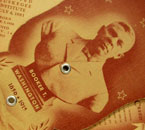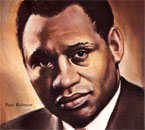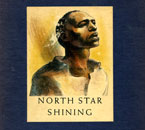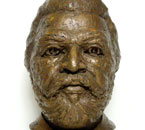In a June 1941 essay in The Crisis, “The Need for Heroes,” Langston Hughes called for a moratorium on negative imagery in the black cultural world. Instead, the writer asked his colleagues to lead the way by turning to positive representations of black achievers and historical figures—”heroes” who would set an example for African Americans, spurring pride and self-esteem, while altering white people’s habitually negative view of the race.
This section explores the celebration of black achievement and accomplishment through visual images—distributed locally and nationally, by producers black and white, and in differing locations and contexts.
Image Credits/Captions (Click on thumbnails for full image)
Booker T. Washington Fan, ca.1945. Collection of Civil Rights Archive/CADVC-UMBC, Baltimore, MD, 2005.1.
Birthday Card, c. 1973. Offset lithography on Paper. 7 x 4 1/2 in. Collection of Civil Rights Archive/CADVC-UMBC, Baltimore, MD, 2005.165
TV Still: KQED News. Take This Hammer, 1963. In one segment from this extraordinary documentary exploring prejudice in the so-called liberal cities of the North, the writer James Baldwin responds to a young African-American student who maintains that there will never be a black president. Baldwin replies that “there will be a Negro president,” but only when African Americans embrace their power by refusing to internalize the negative stereotypes through which society sees them. Watch: https://diva.sfsu.edu/bundles/187041
Hildegarde Hoyt Swift (author), Lynd Ward (Illustrator). North Star Shining: A Pictorial History of the American Negro, 1947. 10 1/2 x 7 x 7/16 in. Collection of Civil Rights Archive/CADVC-UMBC, Baltimore, MD, 2005.201
Inge Hardison, Norbert Rilleux, 1967. “Negro Giants in History” sculpture series; issued by the Old Taylor Distillery Company. Cast plaster. 8 1/2 x 5 1/4 x 5 3/4 in. Collection of Civil Rights Archive/CADVC-UMBC, Baltimore, MD, 2005.268. This portrait of inventor Norbert Rilleux was one of a series of busts created by the African-American sculptor and photographer Inge Hardison and issued by the Old Taylor liquor company as part of a promotional campaign commemorating black innovators.
Golden Legacy Comics #2: The Saga of Harriet Tubman “The Moses of Her People,” 1967. 10 3/8 x 6 3/4 in. Collection of Civil Rights Archive/CADVC-UMBC, Baltimore, MD, 2005.65. Golden Legacy comic books were a series of graphic biographies of African-American historical figures long ignored in mainstream culture. Corporations such as Coca Cola, Exxon, Columbia Pictures, and McDonalds advertised in and helped distribute the free publications to schools, libraries, and civil rights organizations. In addition to teaching history through a dynamic visual format, the books performed a valuable social function, helping to instill pride and self-esteem in black children through the commemoration of black heroes.





